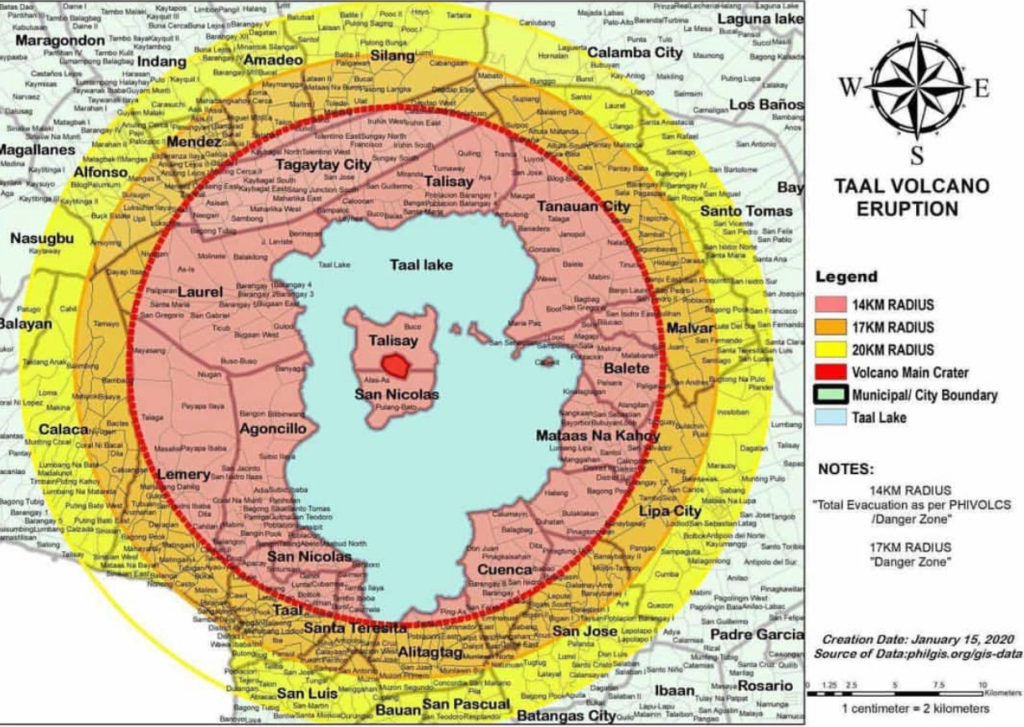 TAAL Volcano – a volcano within a lake within a volcano. This spectacular dreamy view of Taal from Tagaytay is perhaps one of the most memorable sights of the Motherland that we Filipinos already living abroad always go back to.
TAAL Volcano – a volcano within a lake within a volcano. This spectacular dreamy view of Taal from Tagaytay is perhaps one of the most memorable sights of the Motherland that we Filipinos already living abroad always go back to.
Being only 31 miles away from the nation’s capital, this picturesque destination is part of a lot of our warm family memories for our quick day trip from Manila, a wedding, a honeymoon or a retreat and recollection venue. The image of Taal Volcano in Taal Lake from Tagaytay is at the forefront of these memories.
But on January 12, Taal Volcano had awakened. From that picture of serenity, Taal again unleashed its fiery wrath, being the second most active volcano in the Philippines.
Taal Volcano has 34 recorded historical eruptions. Along with the other volcanos in the Philippine archipelago, Taal is part of the “Pacific Ring of Fire,” a major area in the basin of the Pacific Ocean where many earthquakes and volcanic eruptions occur.
Volcanic turmoil had been chronicled since 1572, the year the Augustinian priests founded the town of Taal in the shore of the lake in what is now known as San Nicolas, Batangas. The first recorded most violent eruption happened in 1754 which lasted for 200 days – from May 15 to December 1, which caused the relocation of the towns of Tanauan, Taal, Lipa and Sala.
But one of the most destructive and devastating wrath of Taal happened in January of 1911, killing 1,335 lives and injuring 199, because of scalding by hot steam and/or hot mud. Seven barangays were wiped out, several villages were destroyed, including nipa houses, farms and livestock.
There was more recorded volcanic activity from 1965 to 1977. The 1965 eruption was generated by the interaction of the magma with the lake water that led to the violent explosion akin to an atomic bomb explosion. Such eruption generated surges that travelled across Taal Lake, devastating on the lake shore, killing about a hundred people.
Taal Volcano had a nine-month respite until another similar eruption occurred in 1967. Five months after, in 1968, the volcano produced the first historical lava springing out from Taal. The last major volcanic eruptions occurred in 1976 and 1977.
While there were minor eruptions thereafter, Taal Volcano woke up after 43 years. On January 12, 2020, the eruption started from the main crater on Volcano Island, escalating fast from Alert Level 2 to Alert Level 4.
Taal Volcano spewed toxic ashes to areas covering Metro Manila, Calabar Zone (Cavite-Laguna-Batangas), and even some parts of Central Luzon. Ashfall, volcanic thunderstorms and lightning above its crater with ash clouds and lava fountain were reported and captured on video and reported by major news organizations and shared online.
Mandatory evacuations were made, especially because of the dangers of a possible tsunami. Fissures (ground cracking) have already been observed in the area.
The Philippine Institute of Volcanology and Seismology (PHIVOLCS) of the Department of Science and Technology has been issuing warnings to help save lives.
PHIVOLCS has identified a 14-km “Permanent Danger Zone,” which could be the most vulnerable area for a possible impending violent and devastating explosion. The list as reported by my former colleague Charie Villa:
CAVITE
1. Tagaytay City
2. Silang (Ilang Bahagi)
3. Alfonso (Ilang Bahagi)
4. Mendez (Malaking Bahagi)
5. Indang (Ilang Bahagi)
6. Amadeo (Ilang Bahagi)
BATANGAS
1. Talisay
2. Laurel
3. Agoncillo
4. Taal
5. Santa Teresita
6. Alitagtag
7. Cuenca
8. San Jose (Ilang bahagi)
9 Mataas na Kahoy
10. Balete
11. Malvar
12. City of Tanauan
13. Calaca (Ilang bahagi)
14. San Luis (Ilang Bahagi)
15. Lipa (Ilang Bahagi)
16. San Nicolas
17. Lemery
LAGUNA
1. Ilang bahagi ng Calamba City
2. Ilang bahagi ng Cabuyao City
If you or your family in the Philippines live in any of these areas, please urge them to heed government warnings and evacuation orders even when they think there is a moment of calm. Let us pray for them, our volunteers and government officials. God bless you all!







